Foreign Insulators
by Marilyn Albers
Reprinted from "Crown Jewels of the Wire", June 2001, page 7
TWO NEW GLASS INSULATOR STYLES
THAT WERE MADE AND USED IN ITALY
Guido Boreani of Milano, Italy recently found this rather unusual piece and
brought it to my attention. It is a cemented two piece insulator made of clear
glass with just a tint of straw. "FIDENZA", which is the name of the
company that produced it, is embossed on one side of the dome and the numbers
"6212-1" appear in the same location on the opposite side. The
insulator is four inches in height and the diameter of the outer skirt measures
right about 5-5/8". The diameter of the base is 3-1/2". This beauty
has now been classified as new CD 381.5.
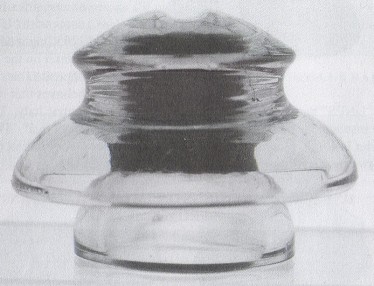
New CD 381.5
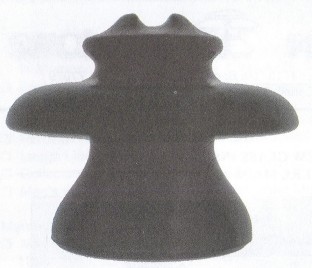
New CD 320.5
This next insulator was also found by Guido, but this one was molded all in
one piece. The color of glass is a beautiful dark emerald green. "MIVA" is embossed on one side of the dome with "UNES 1205" right
across from it on the opposite side. Guido believes that the word "UNES"
may be a power company operating in central Italy. This pretty insulator is 4-1/8" tall and the diameter of the top shell is 5". The base diameter
is 4-1/2". Many thanks Guido, for all the good information on these two new
styles.
UNUSUAL EMBOSSINGS ON TWO WELL KNOWN
CD'S FROM SPAIN
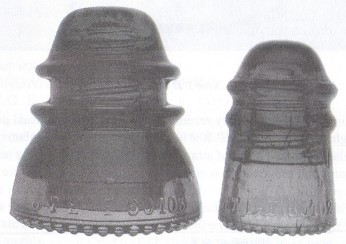
Here are two pretty green glass insulators that were both made by the Spanish
manufacturer known as ESPERANZA E.S.A. As you can see, the larger one on the left is a CD 154 and the smaller insulator to the right is
a CD 106. These are pretty common styles so why am I writing about them? It's
because the embossings on these are unusual and may be rare. Up until a short
time ago, we knew of only one example of CD 154 embossed with the following
letters and numbers "JTE - F 60103", but now this same embossing has
been found on a CD 106 that collector John Nasci found on the Island of Majorca
a few months ago. The only difference in embossing between the two insulators is
that the last two numbers on CD 154 are "03" and may indicate that
this particular insulator is larger in size than CD 106, which has the same
embossing as the 154 but on this one the last two numbers are "02". I
think these numbers may be there to indicate the size of the insulators, so I'll
presume that's right until I can find a good answer. Do any our Crown Jewels
of the Wire readers have this embossing on their Spanish insulators?
TWO VIEWS OF A TRANSFORMER COVER FROM UKRAINE
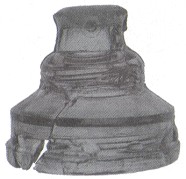
Front View |
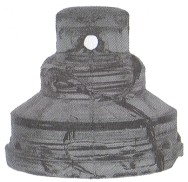
Rear View |
We see here two views of an unusual glass device of probably Russian
manufacture. This small "power insulator" was sent to Tom Katonak by
one of his eastern contacts who obtained it last September from a power plant
worker in a small town in the northern part of the Ukraine. The worker reported
that the power plant from which it came existed prior to WWII and expanded in
the late 1940's. This insulator was in use on one of the pieces of equipment
that was replaced in early 2000. It was probably a transformer or
power-converter of some type. The insulator was likely in service some time in
the 50's or 60's. There are two sets of internal threads on the single skirt of
this insulator indicating that it was screwed onto a double-threaded retainer
and probably covered an electrical terminal on the power device when the equipment was not on line.
Interestingly, the top of the insulator has two small indentations on either
side to which a wire retainer clip may have been affixed. This would have
allowed the insulator to be hung from a peg or hook in handy proximity to the
transformer. There is also a 1/4" hole in the side of the insulator top that
appears to have been drilled through the glass post-manufacture. One can
speculate that this hole was used to insert a grounding conductor through the
glass insulator to perhaps discharge or ground the equipment.
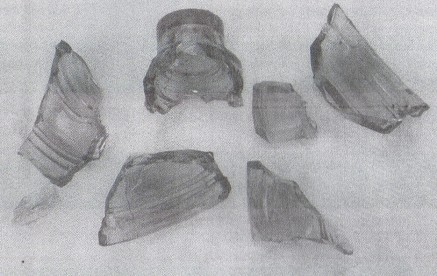
When the insulator arrived in America, it had been reduced to numerous shards
of light aqua glass! It is not clear whose postal service is to blame! Tom glued
it back together well enough to permit photometric documentation. This piece is
of a light aqua glass and measures 4 inches wide by 3-5/8 inches high. Not being
a pin-type insulator, there probably won't be a design reference number assigned
in the foreseeable future!
Many thanks to Tom Katonak for including the write up on "Two views of a
transformer cover from Ukraine".
| 